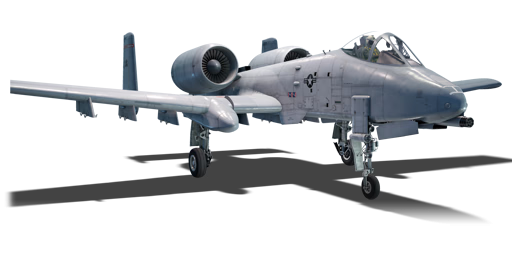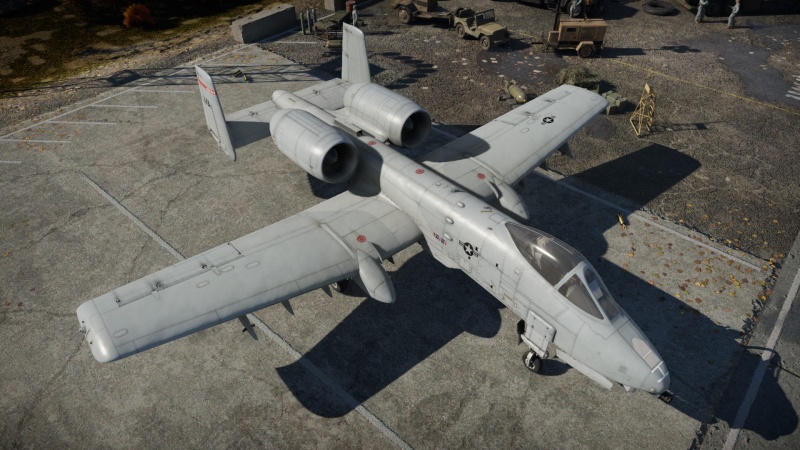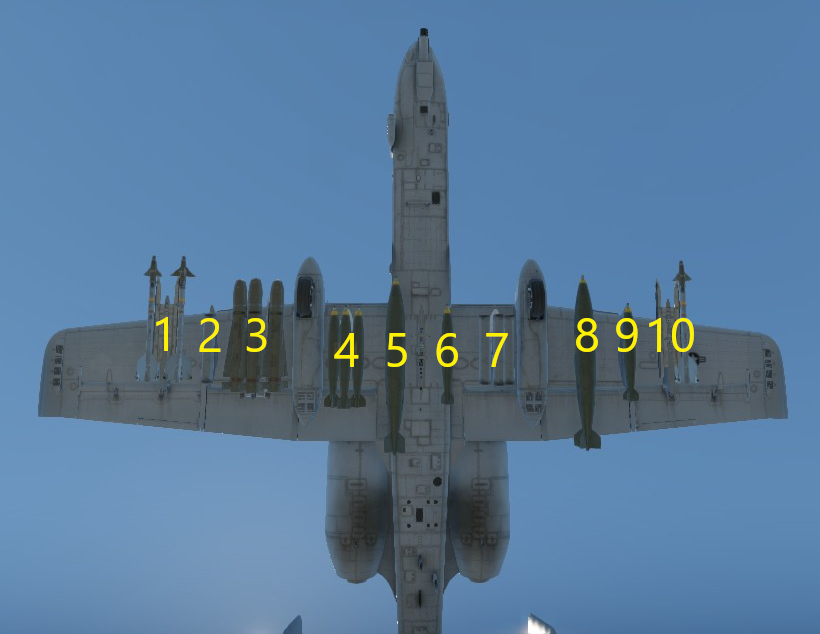Difference between revisions of "A-10A Late"
BravoTrooper (talk | contribs) (→Pros and cons) (Tag: Visual edit) |
BravoTrooper (talk | contribs) (→History: Added the brief history of the A-10A) (Tag: Visual edit) |
||
| Line 223: | Line 223: | ||
== History == | == History == | ||
| − | + | After WWII, American aircraft designers shifted focus toward developing tactical aircraft capable of delivering nuclear weapons while conventional strike aircraft fell out of favor with the new American military doctrine. By the start of the Vietnam War however, the A-1 Skyraider, being the most widely used strike aircraft in U.S. service at the time, was considered vastly outdated. Furthermore, new aircraft such as the very successful F-4 Phantom II proved to be too expensive for strike mission operations. | |
| − | + | ||
| + | As a result, in September 1966 the USAF ordered the development and procurement of a dedicated new close air support aircraft, resulting in the A-X program being launched shortly afterwards. In May 1970, the first requirements were issued, including the need to design the aircraft around a new 30mm rotary cannon. Of six aircraft manufacturers who submitted design proposals, the two from Northrop and Fairchild Republic were chosen for further development, resulting in two prototypes: the YA-9A and YA-10A, respectively. After intensive testing of both prototypes, the YA-10A was declared the winning design and was ordered into production in January 1973. | ||
| + | |||
| + | After the USAF received its first production version of the A-10 in November 1975, the aircraft received its official name "Thunderbolt II" in April 1978 in honour of the WWII-era P-47 fighter-bomber also built by Republic. Although the A-10 was first assigned to a military unit in March 1976, its first combat use would be in 1991 as part of the Gulf War. During this conflict, the A-10 underwent its baptism by fire and successfully proved its design, racking up an impressive number of enemy targets destroyed. A-10s were also employed during the Balkan conflicts of the mid and late 1990s as well as during the Invasion of Afghanistan and Iraq in the early 2000s. The A-10 Thunderbolt II, despite its age, still forms the backbone of the USAF's close air support force to this date, with over 700 units of the A-10 being produced in total. | ||
== Media == | == Media == | ||
Revision as of 21:09, 4 August 2022
| This page is about the American strike aircraft A-10A Late. For the premium version, see A-10A. |
Contents
Description
The A-10A Thunderbolt II (Late) is a rank VII American strike aircraft with a battle rating of 10.3 (AB) and 10.7 (RB/SB). It was introduced in Update "Wind of Change".
General info
Flight performance
The single biggest downside with the A-10 is its top speed. At 642 km/h at sea level, the A-10A is the slowest aircraft at its BR. Not enough emphasis can be put on how much of a disadvantage the A-10's speed is, especially at a battle rating of 10.0, where apart from another A-10, every single aircraft it faces will have at least a 400 km/h faster top speed.
Despite how crippling the A-10's speed is, there are a handful of advantages to being so slow. First, while it is slow, it still is manoeuvrable at those low speeds, even with a heavy weapon loadout. It also means that its turn time is tight and quick compared to supersonic aircraft.
| Characteristics | Max Speed (km/h at 0 m - sea level) |
Max altitude (metres) |
Turn time (seconds) |
Rate of climb (metres/second) |
Take-off run (metres) | |||
|---|---|---|---|---|---|---|---|---|
| AB | RB | AB | RB | AB | RB | |||
| Stock | 624 | 609 | 12497 | 30.2 | 30.8 | 21.0 | 19.9 | 700 |
| Upgraded | 662 | 642 | 28.5 | 29.0 | 30.3 | 25.3 | ||
Details
| Features | |||||
|---|---|---|---|---|---|
| Combat flaps | Take-off flaps | Landing flaps | Air brakes | Arrestor gear | Drogue chute |
| X | ✓ | ✓ | ✓ | X | X |
| Limits | ||||||
|---|---|---|---|---|---|---|
| Wings (km/h) | Gear (km/h) | Flaps (km/h) | Max Static G | |||
| Combat | Take-off | Landing | + | - | ||
| 874 | 370.4 | N/A | 740 | 370 | ~__ | ~__ |
| Optimal velocities (km/h) | |||
|---|---|---|---|
| Ailerons | Rudder | Elevators | Radiator |
| < 550 | < 650 | < 500 | N/A |
Engine performance
| Engine | Aircraft mass | |||||||
|---|---|---|---|---|---|---|---|---|
| Engine name | Number | Basic mass | Wing loading (full fuel) | |||||
| General Electric TF34-GE-100A | 2 | 11,636 kg | ___ kg/m2 | |||||
| Engine characteristics | Mass with fuel (no weapons load) | Max Takeoff Weight | ||||||
| Weight (each) | Type | 14m fuel | 20m fuel | 30m fuel | 45m fuel | 48m fuel | ||
| 654 kg | High-bypass turbofan | 13,092 kg | 13,651 kg | 14,659 kg | 16,170 kg | 16,489 kg | _,___ kg | |
| Maximum engine thrust @ 0 m (RB/SB) | Thrust to weight ratio @ 0 m (100%) | |||||||
| Condition | 100% | WEP | 14m fuel | 20m fuel | 30m fuel | 45m fuel | 48m fuel | MTOW |
| Stationary | 4,036 kgf | N/A | 0.62 | 0.59 | 0.55 | 0.50 | 0.49 | _.__ |
| Optimal | 4,036 kgf (0 km/h) |
N/A | 0.62 | 0.59 | 0.55 | 0.50 | 0.49 | _.__ |
Survivability and armour
The A-10A has substantial armour around the cockpit, fuel tanks, and transmission. This armour is mostly effective toward autocannons up to 25 mm calibre.
- 38 mm titanium alloy - "bathtub" around the bottom of the cockpit
- 44 mm bulletproof glass (54°) - windshield in front of the pilot
The A-10A is equipped with a whooping 480 countermeasures. This gives an extended and effective protection against even the most potent heat-seeking missiles it will face. However, while the pilot has ample armour protection, the other parts of the plane, such as the wing, tail and especially the unarmoured and exposed engines, will easily be destroyed by any short cannon burst.
Modifications and economy
Armaments
| Ballistic Computer | |||
|---|---|---|---|
| CCIP (Guns) | CCIP (Rockets) | CCIP (Bombs) | CCRP (Bombs) |
| |
|
|
|
Offensive armament
The A-10A Late is armed with:
- A choice between two presets:
- 1 x 30 mm GAU-8/A cannon, chin-mounted (1,174 rpg)
- 1 x 30 mm GAU-8/A cannon + 480 x countermeasures
Suspended armament
The A-10A Late can be outfitted with the following ordnance:
- Without load
- 2 x AIM-9L Sidewinder missiles
- 42 x Hydra-70 M247 rockets
- 84 x Hydra-70 M247 rockets
- 84 x Hydra-70 M247 rockets + 4 x AIM-9L Sidewinder missiles
- 10 x 500 lb LDGP Mk 82 bombs (5,000 lb total)
- 12 x 500 lb LDGP Mk 82 bombs (6,000 lb total)
- 12 x 500 lb LDGP Mk 82 bombs + 4 x AIM-9L Sidewinder missiles (6,000 lb total)
- 6 x 2,000 lb LDGP Mk 84 bombs (12,000 lb total)
- 6 x 2,000 lb LDGP Mk 84 bombs + 4 x AIM-9L Sidewinder missiles (12,000 lb total)
- 6 x AGM-65D missiles
- 6 x AGM-65D missiles + 4 x AIM-9L Sidewinder missiles
- 4 x AIM-9L Sidewinder missiles
Custom loadout options
| 1 | 2 | 3 | 4 | 5 | 6 | 7 | 8 | 9 | 10 | ||
|---|---|---|---|---|---|---|---|---|---|---|---|
| AIM-9L Sidewinder missiles | 1, 2 | 1, 2 | |||||||||
| 500 lb LDGP Mk 82 bombs | 1 | 1 | 1, 3 | 1, 3 | 1 | 1 | 1, 3 | 1, 3 | 1 | 1 | |
| Hydra-70 M247 rockets | 7 | 7, 21 | 7, 21 | 7, 21 | 7, 21 | 7 | |||||
| AGM-65D missiles | 3 | 3 | |||||||||
| 2,000 lb LDGP Mk 84 bombs | 1 | 1 | 1 | 1 | 1 | 1 | |||||
| Maximum permissible weight imbalance: 1,000 kg | |||||||||||
Usage in battles
The A-10A Late is specifically designed to attack ground targets. The AGM-65Ds and Mk 84s provide substantial firepower against armoured ground units. When within range, the 30 mm GAU-8 cannon can be used: the gun may lack penetration power against armour, but is excellent at destroying exterior modules and inflicting damage by overpressure.
The A-10's low speed makes it difficult to reach enemy ground units and bases without being intercepted, and also makes the A-10 especially vulnerable to both attacking aircraft and SAMs. Another problem with being so slow is that it is very easy to get energy trapped. This means that any common enemy aircraft can simply fly above the A-10, and with its slow speed, it simply has no chance to follow and get in range to use its gun. After the A-10 inevitably pitches back down (or stalls), the enemy aircraft will dive down on the slow and vulnerable A-10. While the A-10 can utilize its all-aspect AIM-9Ls to potentially dispatch aircraft lacking flares before they can initiate an energy trap, flare-equipped aircraft (which can easily flare an AIM-9L) should never be engaged unless absolutely necessary as it will likely result in the A-10's destruction. This speed also disadvantages the A-10 in high-speed head-ons. While it does arguably have the most powerful gun in the game, the A-10 will have trouble dodging the rounds of an enemy aircraft because its low speed prevents it from quickly getting out of the way. Meanwhile, the enemy aircraft, which is likely going much faster than the A-10, won't have too much of a problem dodging the A-10's rounds provided they begin evading at an ample range.
However, the slow speed allows the A-10 much more time to aim its weapons at ground targets than if it were, say, a supersonic aircraft that is unmanoeuvrable at low speeds. Due to this, the A-10 can farm ground targets quicker than most other planes; with its 1,174 rounds of 30 mm, a single A-10 left unchecked to freely attack ground targets can reduce an enemy team's ticket count by half or more. As stated before, the A-10 has very little chance in a vertical dogfight. However, the A-10's slow speed and good low speed manoeuvrability gives it the advantage in a horizontal scissors dogfight, as the likely faster enemy aircraft will quickly pass in front of the A-10's devastating gun. In a prolonged horizontal low speed scissors dogfight, the enemy aircraft would have likely bled much of their speed, again giving the A-10 an advantage with its good low speed manoeuvrability. If the enemy attempts to run away, the A-10 can exploit their low speed to launch an AIM-9L. When flying the A-10, if you notice an attacking aircraft may be unaware of the A-10's speed weakness (or unaware of how to exploit it), attempt to force it into a horizontal turn fight or scissors where you will have the advantage.
Pros and cons
Pros:
- Good manoeuvrability
- Great roll rate
- Good armour protection around the cockpit area that will protect the pilot
- 480 countermeasures are extremely effective against common heat-seeking missiles
- Devastating cannon with a large ammo pool
- Great payload options for ground attack
- Access to four all-aspect AIM-9L Sidewinder air-to-air missiles
- Sturdy wings which are hard to rip and don't break in dives
- Access to AGM-65D Air-to-Ground TV guided missiles which can fire during night operation unlike the AGM-65B
- The aircraft's slow speed means G-forces sustained during maneuvers isn’t much of an issue
Cons:
- Bad climb rate compared to other jets
- Does not have access to either gunpods or guided bombs
- Extremely poor top speed makes it easy prey
- Engine can potentially overheat when running at or near 100% throttle unless on a winter map
History
After WWII, American aircraft designers shifted focus toward developing tactical aircraft capable of delivering nuclear weapons while conventional strike aircraft fell out of favor with the new American military doctrine. By the start of the Vietnam War however, the A-1 Skyraider, being the most widely used strike aircraft in U.S. service at the time, was considered vastly outdated. Furthermore, new aircraft such as the very successful F-4 Phantom II proved to be too expensive for strike mission operations.
As a result, in September 1966 the USAF ordered the development and procurement of a dedicated new close air support aircraft, resulting in the A-X program being launched shortly afterwards. In May 1970, the first requirements were issued, including the need to design the aircraft around a new 30mm rotary cannon. Of six aircraft manufacturers who submitted design proposals, the two from Northrop and Fairchild Republic were chosen for further development, resulting in two prototypes: the YA-9A and YA-10A, respectively. After intensive testing of both prototypes, the YA-10A was declared the winning design and was ordered into production in January 1973.
After the USAF received its first production version of the A-10 in November 1975, the aircraft received its official name "Thunderbolt II" in April 1978 in honour of the WWII-era P-47 fighter-bomber also built by Republic. Although the A-10 was first assigned to a military unit in March 1976, its first combat use would be in 1991 as part of the Gulf War. During this conflict, the A-10 underwent its baptism by fire and successfully proved its design, racking up an impressive number of enemy targets destroyed. A-10s were also employed during the Balkan conflicts of the mid and late 1990s as well as during the Invasion of Afghanistan and Iraq in the early 2000s. The A-10 Thunderbolt II, despite its age, still forms the backbone of the USAF's close air support force to this date, with over 700 units of the A-10 being produced in total.
Media
- Skins
- Videos
See also
Links to the articles on the War Thunder Wiki that you think will be useful for the reader, for example:
- reference to the series of the aircraft;
- links to approximate analogues of other nations and research trees.
External links
| Fairchild Aircraft | |
|---|---|
| Jet aircraft | A-10A · A-10A Late · A-10C |
| USA jet aircraft | |
|---|---|
| Fighters | |
| F9F | F9F-2 · F9F-5 · F9F-8 |
| F-80 | F-80A-5 · F-80C-10 |
| F-84 | F-84B-26 · F-84F · F-84G-21-RE |
| F-86 | F-86A-5 · F-86F-25 · F-86F-2 · F-86F-35 |
| F-89 | F-89B · F-89D |
| F-100 | F-100D |
| F-104 | F-104A · F-104C |
| F-4 | F-4C Phantom II · F-4E Phantom II · F-4J Phantom II · F-4S Phantom II |
| F-5 | F-5A · F-5C · F-5E · F-20A |
| F-8 | F8U-2 · F-8E |
| F-14 | F-14A Early · ▄F-14A IRIAF · F-14B |
| F-15 | F-15A · F-15C MSIP II · F-15E |
| F-16 | F-16A · F-16A ADF · F-16C |
| Other | P-59A · F2H-2 · F3D-1 · F3H-2 · F4D-1 · F11F-1 |
| Strike Aircraft | |
| FJ-4 | FJ-4B · FJ-4B VMF-232 |
| A-4 | A-4B · A-4E Early |
| A-7 | A-7D · A-7E · A-7K |
| AV-8 | AV-8A · AV-8C · AV-8B Plus · AV-8B (NA) |
| A-10 | A-10A · A-10A Late · A-10C |
| F-111 | F-111A · F-111F |
| Other | A-6E TRAM · F-105D · F-117 |
| Bombers | |
| B-57 | B-57A · B-57B |






